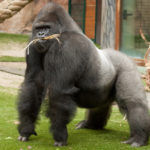Gorillas – information
 Gorillas are our closest relatives, after chimpanzees. They have about 98% of our genes. Like people, gorillas have two hands with 5 fingers on each “hand”, and two legs with 5 fingers on each “leg”. They have two small ears. However, unlike people, the arms are longer and more powerful than the legs. Their bodies are covered with thick dark hair and as soon as the male reaches 15 years, the hair on the back begins to acquire a silvery-gray color.
Gorillas are our closest relatives, after chimpanzees. They have about 98% of our genes. Like people, gorillas have two hands with 5 fingers on each “hand”, and two legs with 5 fingers on each “leg”. They have two small ears. However, unlike people, the arms are longer and more powerful than the legs. Their bodies are covered with thick dark hair and as soon as the male reaches 15 years, the hair on the back begins to acquire a silvery-gray color.
The male gorilla can sit 20 kg of food every day. When gorillas do not sleep or rest, they spend most of their time taking food. Most of the elements of their diet are leaves, fruits, bulbs and grapevines. However, they also feed on ants, termites, worms and larvae of insects.
Despite the negative feedback about them, gorillas are shy and peaceful animals, whose only natural enemy is a person. They are still hunted like wild animals and their bones and skins are still taken as trophies. In the past, young gorillas were highly regarded as pets in zoos, and in the process of capture, hunters often killed other family members when they tried to protect the child.
The female gorilla usually reaches maturity at the age of about 8 years. Pregnancy usually lasts from 8 to 9 months and females, as a rule, give birth to about 3 children per lifetime. Newborn gorillas, as a rule, weigh from 1.5 to 2 kg, which is about half the weight of a human child.
Young gorillas are very playful and are better able to climb trees than their larger relatives. The group of gorillas usually includes one silver male, who is the head of the family, one immature male at the age of 8 to 13 years, 3-4 adult females, and 3-6 young representatives under the age of 8 years.
Gorillas are very intelligent animals and can exhibit a wide range of emotions. They know how to manifest positive emotions, such as love, joy, pride, empathy and generosity, and negative emotions such as fear, hatred, greed, shame and jealousy. They can laugh when they are tickled and cry when they are sad. However, they do not cry with tears, as people do, but with sounds.



























